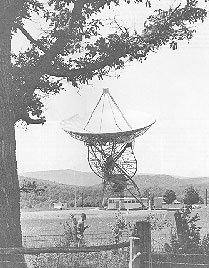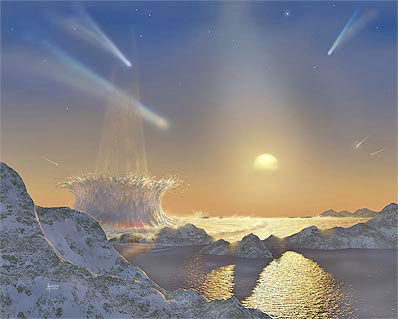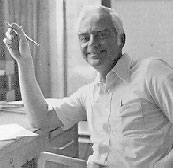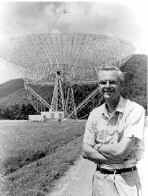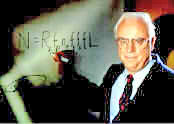|
|
|
from
DavidDarling Website The first systematic attempt to detect artificial radio signals from nearby stars.
Named after the princess
in Frank Baum's
Drake began preparations for Ozma in 1959, the same year in which the seminal theoretical paper on SETI by Philip Morrison and Guiseppe Cocconi was published in the British journal Nature.
These developments, although occurring more or less simultaneously (the paper appeared about 6 months after Drake began his work), were quite independent of one another.
Both, however, concluded that the best chance of success would come from searching at a radio wavelength of 21.1 cm (corresponding to a frequency of 1,420 MHz) since the 21-centimeter line of neutral hydrogen in the Galaxy might represent a natural hailing wavelength at which intelligent species would try to communicate.
As his target, Drake chose two nearby, reasonably
Sun-like stars,
epsilon
From April to July 1960, he tuned into both for six hours a day, using the 85-ft.
Howard E. Tatel radio telescope at Green Bank (shown in the photo) equipped with a receiver that had just a single channel and a bandwidth of only 100 Hz.
Although after 150 hours of listening Ozma drew a blank,
it was to be the starting point for many more, increasingly
sophisticated searches which continue to this day.1,
2
Cosmic Search Vol. 1, No. 1
from
BigEar Website
I really have two quite vivid memories of those days-first, of the battle against the cold each morning as I would climb to the focus of the dish to tune the parametric amplifier, and then of that moment on the first day of the search when a strong unique pulsed signal came booming into the telescope just as soon as we had turned it towards the star Epsilon Eridani.
But a lot of other important things happened then, and the importance of some of them wasn't apparent until years later.
Green Bank was a very exciting place in 1959. We had been given the charter, and what amounted to unlimited funds, to build the best radio observatory in the world.
We had
started to build a very costly telescope, the 140-foot, completion
of which was still years in the future, and we knew that we really
should build a smaller telescope first to get the place into
operation, to gain some experience and momentum. So a contract was
made to build an 85-foot telescope, and by early 1959 it stood
there, a striking anachronism in those primitive mountains of West
Virginia.
About ten light years, it turned out. And a
few stars very much like the sun were within that distance.
One snowy day in late winter we all drove down to this forlorn place and during lunch I mentioned my conclusion that we could possibly detect intelligent radio signals from some nearby stars with the new telescope. I suggested we put together some simple equipment to do the task-it took something we didn't usually use in radio astronomy, a narrow band radio receiver-and search some nearby stars for signals.
At the time, the director of the National
Radio Astronomy Observatory was Lloyd Berkner, a pioneer in
ionospheric studies and something of a scientific gambler, and he
was all for it. So as the last greasy french fry was washed down by
the last drop of Coke, Project Ozma was born.
The narrow band radio receivers to be used in Ozma would be just right to search for the Zeeman* effect in the 2l-cm line of neutral hydrogen. Thus, if we set up the equipment for that wavelength, we could use it for that important experiment. In addition, it would head off any criticism that we were putting resources into the equipment wastefully.
In the end we spent only
about $2000 for the unusual parts of the receiver, and no one ever
complained.
We also planned to have an ordinary audio tape recorder connected to the system just in case something did come in from outer space! There were some other important special aspects of the receiver. It switched between two feed horns so as to allow us to distinguish a signal from space from a terrestrial signal coming in the side-lobes of the antennas.
The same approach has been used in some form in just about all the searches since. Also, there was a reference channel to which the signal channel was compared; this was a standard technique in those days and now, and was used to eliminate receiver gain fluctuations and nonlinearities.
Since our
band-pass was to be 100 hertz, the oscillators used in the receiver
had to be a bit more stable than usual, although nothing very
challenging. After a while Kochu Menon, an old friend and colleague
from Harvard, came to Green Bank and worked on the receiver also.
Giuseppe Cocconi and Phil Morrison of Cornell published their deservedly famous paper in Nature in September containing the same calculations I had made, pointing out that mankind could detect other civilizations with existing radio telescopes, and suggesting the 21-cm line as the most promising band to search for signals.
For a good reason the
unique status of this fundamental spectral line of the most abundant
and fundamental atom of our universe, and not for the practical
reason which had influenced me. It made us feel good because now
there were further arguments for what we were doing.
I visited with Giuseppe Cocconi
about a year ago in Geneva, where he is an active nuclear physicist
at CERN.
So, he
was for Ozma from the start, and was urging us to hurry with the
project.
So, to our surprise he was very agitated and frustrated when the Cocconi-Morrison paper appeared. He was very worried that Green Bank was going to lose the credit for what he thought was an important idea.
Actually, from the beginning of Ozma we had expected that any public announcement of it would bring a horde of reporters down on our heads, and so we had kept the whole thing as quiet as possible. Now Struve was very upset that we had done that.
He did what he could-about a month later he
was scheduled to give some prestigious lectures at MIT, and he used
the occasion to ballyhoo all the activity at Green Bank in
connection with the search for extraterrestrial life. The cat was
out of the bag: looking back now, only good came from letting it
out.
The realm of electronics had recently been turned topsy-turvy by two inventions-the solid-state maser,* and the parametric amplifier.* Both gave receiver sensitivities as much as ten times better than what had been in use.
But both were laboratory devices, and could not be used in practice in the field on a moving radio telescope. So we were thrilled when a person who was simultaneously an avid radio ham, an intelligent life buff, and the president of one of the most sophisticated American electronic companies, Microwave Associates, offered us the use of a working parametric amplifier, probably the best in the world.
This was Dana Atchley, Jr. Not only would he
provide the amplifier, but he would send his chief engineer with it
to install it.
Going downstairs, I got a real jolt but kept my cool as I saw before me:
The driver was Sam Harris, known to every radio ham as a radio amateur magazine editor, and known to many and soon to me as an electronics genius.
He had designed the parametric amplifier, and was the only one in the world who could make it work, and it really worked. He proceeded to install it, make it do its magic, and then taught me how to tune it, the task which became my four-o'clock-in-the-morning pick-me-up for the day.
When all was
well, he climbed back in his Morgan and drove off. I never saw him
again until one day in 1966, 1 met that red beard again; this time
he was on the staff of my observatory at Arecibo (I had nothing to
do with this improbable event), and he has been there ever since,
doing his magic.
At the 85-foot telescope, the operator would turn the telescope so that I could climb into the metal can, not much bigger than a garbage can, which was at the telescope's focus. There I would sit for about 45 minutes twiddling the micrometer adjustments on the parametric amplifier, talking to the telescope operator, as we set Sam Harris's gizmo so that it was doing the right thing.
In the beginning we would have to do this several times a day as the changing temperature upset the tuning, but as time went on we found ways to evade that problem. After the amplifier was all tuned, I climbed down from the focal point, went into the control building, and set up the Ozma receiver.
It was built to tune slowly in frequency so that it shifted its frequency about 100 hertz every minute.
Hypothetical planet of Tau Ceti. Painting by David Harding
Then we pointed the telescope at our prime target, the nearby solar-type star Tau Ceti. Once the telescope was tracking the star's position, and the receiver was set on the starting frequency, we turned on the tuning motor, the chart recorder, and the tape recorder.
Project Ozma was underway!
Whenever you search for extraterrestrial intelligent radio signals, you always feel at the beginning that the signal may pop up right away.
And so the telescope operators and I spent a breathless morning peering at the wiggling pen on the chart recorder, thinking that every time the pen started to deflect up that this was IT.
Only to see the pen go down again, obeying the
universal law of gaussian noise statistics. And so it went until
noon, when
Tau Ceti set in the west.
Again we started the chart and tape recorders,
and settled back for more of what had already become routine.
We all looked at each other wide-eyed. Could it be this easy? Some people had even predicted that the most rational extraterrestrial signal would be a slow series of pulses, as that would be evidence of intelligent origin. (No one had any idea about the existence of pulsars then.) Suddenly I realized that there had been a flaw in our planning.
We had thought the detection of a signal so unlikely that we had never planned what to do if a clear signal was actually received. Almost simultaneously everyone in the room asked "What do we do now?" Change the frequency?
Well, the most likely source of a spurious signal was the earth, and we could check that out by moving the telescope off the star and seeing if the signal went away. So we proceeded to do that, and as we moved off the star, sure enough the signal went away. So we pointed back at the star. The signal did not come back. Wow. Was it really from the star, or had it been from earth and had it turned off about the time we moved off the star?
There was no way to know. And there was all
that adrenaline flowing and no way to apply all that excitement and
energy in a useful way.
We also connected a second receiver to a simple horn antenna which looked out of the control room and could pick up interference. A week went by and the signal didn't return. To our chagrin, one of our employees called up a friend in Ohio and told him about the signal.
The word was passed to a newspaper reporter friend, and suddenly we were deluged with inquiries about the mysterious signal
And so, aha, we were hiding something.
To this day many people believe falsely that we received signals
from another world, and that some fiendish government agency has
required us to keep this a deep dark secret.
It even got dull, and I realized that as important and exciting as is a search for extraterrestrial signals, such searches should only be done in conjunction with regular astronomical research, so that there will be real results all the time to remind the searchers that there are, after all, strange and wonderful things in the sky.
So they will keep looking.
We had some special visitors at Green Bank during Project Ozma, visitors who are more remarkable in retrospect than they were at the time.
One who came for several days
was Theodore Hesburgh, then the very young president of Notre Dame
University, and an up-and coming theologian. He felt that the search
for extraterrestrial life was an inspiring and a very good thing to
do. He has written the forward to the most recent SETI study.
So he came to Green Bank, and sat quietly in one corner of the control room, watching us go through our mysterious manipulations of cables and dials, for days on end, waiting for lightning to strike.
Subsequently he published some of the best discussions of the nature
and importance of the search for extraterrestrial life.
Actually, as it turned out, it was not at all surprising that he was there, because he too had thought about the means for detecting other civilizations for many years. A successful inventor, electronics expert, and physicist, he already knew all about it, and was glad that someone had the opportunity at last to do something. Since then he has decided that a lot more should be done about it.
Recently as the project director of the Project Cyclops Study, "Barney" Oliver has become the leader in the development of plans for enormously sophisticated systems for the detection of extraterrestrial intelligent radio signals.
When he has his way, as he will some day,
we will see radio telescopes ten thousand times larger than the 85
-foot telescope scanning the sky, on not one, but perhaps billions
of frequencies at once. Good.
But no more telescope time could be committed to the
project; there was a lot of astronomy to do. And so Project Ozma was
over.
Only by doing the best we can with the very best that an era offers, do we find the way to do better in the future.
Just as Project Ozma contributed to the development of the much better systems of today, so the giant telescopes and computers of today will be replaced with even grander instruments in the future.
A ladder doesn't work if some of its rungs are missing; they all have to be there, and you have to step on them all one at a time.
by Carol Oliver from SETIAustralia Website
There was a chill in the Spring air in
the hills around the Green Bank National Radio Astronomy Observatory
in West Virginia, USA on April 8, 1960. The young Dr Frank Drake and
some students had set out on one of the most audacious of all
experiments.
In his hands was the means to go beyond that wonder that had existed for thousands of generations - to scientifically search for evidence to answer the question 'are we alone?'. Drake's Project Ozma would search Tau Ceti and Epsilon Eridani for two hundred hours.
The technology to do SETI has dramatically improved over the years, and continues to improve. In SETI Australia - only five years' old - we are searching with not one radio channel, but 58 *million* channels.
We are not searching within a mere ten light years, but up to around 1,000 light years (a light year is the distance light travels in one year at around 300,000 kilometers per second).
Even that is small compared to the size of the Milky Way, the galaxy that is our celestial home -
100,000 light years across. The one thing to be learned early on
with SETI is that space is filled with an awful lot of space!
This requires huge radio telescopes, like the planned Square
Kilometer Array, and an improvement in the computing capability of
SETI equipment, but both are in the 'likely to happen' basket in the
next decade or two.
In the meantime, the search is relatively cheap to do and in most cases it requires no specific telescope time of its own. As was said as far back as 1959, just months before Drake initiated Project Ozma, if you don't look the chances of success are zero.
Since 1960 there have been some 60 projects. Today there a number of international projects, the three biggest being,
SETI Australia continues its project because the chances of success are NOT zero and it is a reasonable experiment to do given the clues that life might be quite common in the universe.
It is also possible to do other good science with the same technology while searching.
In addition, it has spin-offs such as our science education project.
In 2000, with help from our friends at the SETI Institute, SETI
entered the New South Wales science curriculum as a context for
teaching science and in a way that allows high school students to
learn and use the tools of science.
|


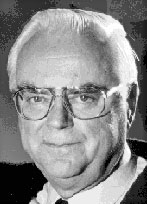 Wizard of Oz, it was the brainchild of American
radio astronomer
Wizard of Oz, it was the brainchild of American
radio astronomer
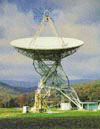 Eridani
Eridani